How Often Should Beginners Run? Build a Smart Routine Without Burnout

Wondering how often you should run as a beginner?
You’re not alone.
It’s tempting to hit the ground running — logging 3 to 5 sessions a week right from the start. But as a chiropractor who’s worked with countless running injuries, I can tell you: that’s where many new and returning runners go wrong.
Beginners often ramp up too fast. And if you’re a seasonal runner coming back after a long break, it’s easy to assume you can pick up where you left off — but your body might not be ready for that pace just yet.
Trying to match your old routine too soon? That’s a fast track to injury.
👉 Check this guide on how to find the right running pace.
Don’t worry — I’ve got your back.
In this post, you’ll learn how often beginners should run to avoid burnout, dodge overuse injuries, and build real progress.
Ready to lace up and train smarter for your next race (or first one)? Let’s go.
✅ Key Takeaway (TL;DR)
- Most beginner runners should aim to run 2–4 days per week
- Include rest days and optional cross-training like strength work or brisk walks
- A balanced training plan helps reduce injury risk and improves performance
- Your weekly mileage should be low and manageable early on
- As your fitness level increases, you can add running days, adjust training volume, and progress gradually
How Often Should You Run?
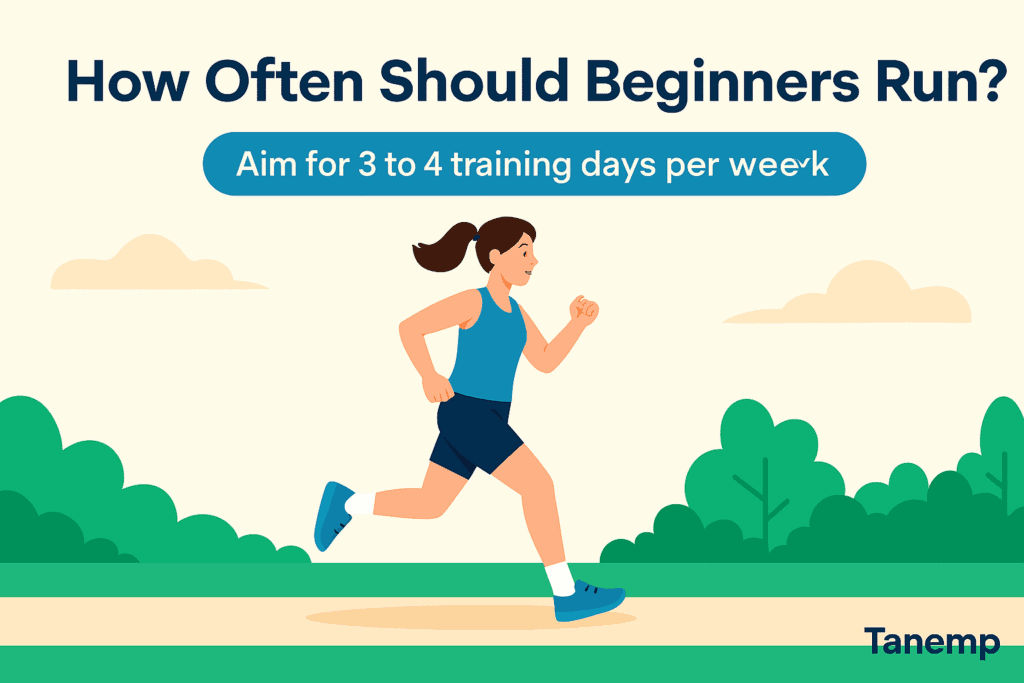
The sweet spot for most beginner runners is 2 to 4 days per week. That gives your body time to adapt while helping you build consistency, without overloading your musculoskeletal system before it’s ready.
Research organizations like the American College of Sports Medicine (ACSM) recommend novice runners start with 2–3 days per week, moving up to 4–5 days as you gain experience
You don’t need to run every day to make progress. Most new runners see better results when they:
- Run every other day
- Avoid stacking hard workouts
- Keep total training volume and weekly mileage low
This helps reduce injury risk and gives your body the musculoskeletal system time it needs to recover and grow stronger. Learn more about smart muscle recovery tips here.
Let me give you an example:
One of my patients, a weekend runner, took a break from running during the school year. After three months off, she suddenly jumped back in — running 20 minutes nonstop, four times a week. She insisted she was running “slowly,” but the result? The same knee pain that originally brought her to my office.
The takeaway? Even if it feels like you’re easing in, your body may not agree, especially after time off. Don’t rush the mileage. Give your body time to adapt, and you’ll be able to run longer and pain-free in the long run.
Why Rest Days Matter More Than You Think
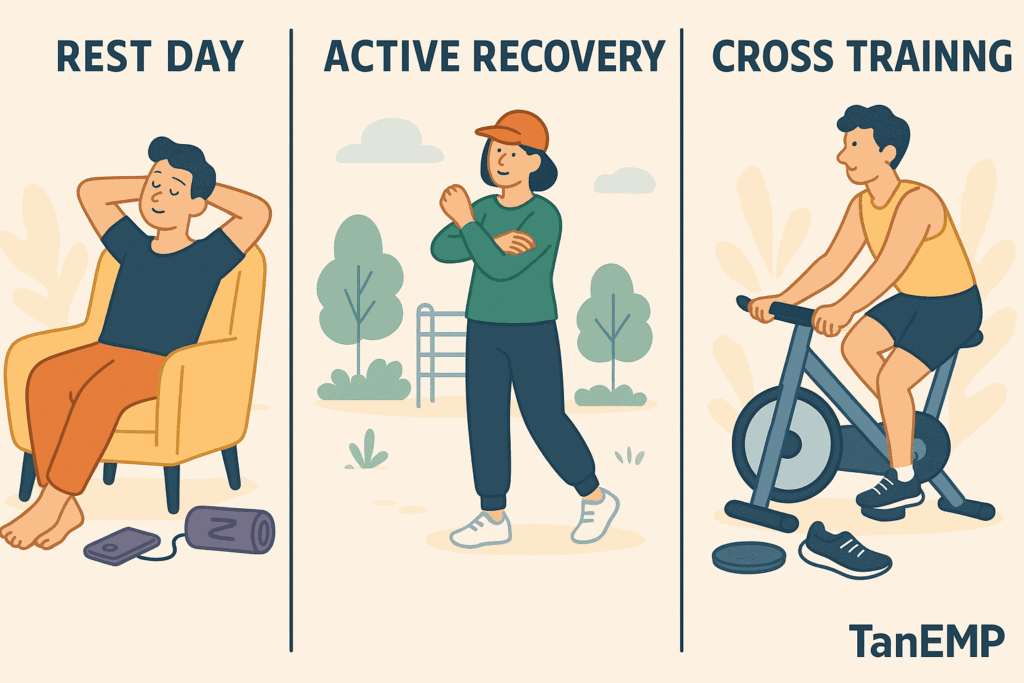
Rest days are training days.
Your body needs time to repair joints, muscles, and connective tissue. If you skip recovery days, you’re just stacking subsequent workouts on top of fatigue.
Many younger runners skip recovery because they think it’s unnecessary, but as a chiropractor, I can tell you recovery matters at every age. And no, it’s not just lying on the couch with Netflix.
Active recovery counts too — things like stretching, yoga, walking, a low-impact treadmill workout, or simply making sure you’re getting proper hydration all help your body bounce back stronger.
Rest days improve:
- Long-term fitness level
- Overall running performance
- Your ability to run more often later
They also help prevent common running injuries and reduce the risk of overuse.
Don’t be afraid to build in both recovery days and non-running days — that’s how you stay consistent and injury-free for the long run.
What Are the Best Cross-Training Options for Runners?
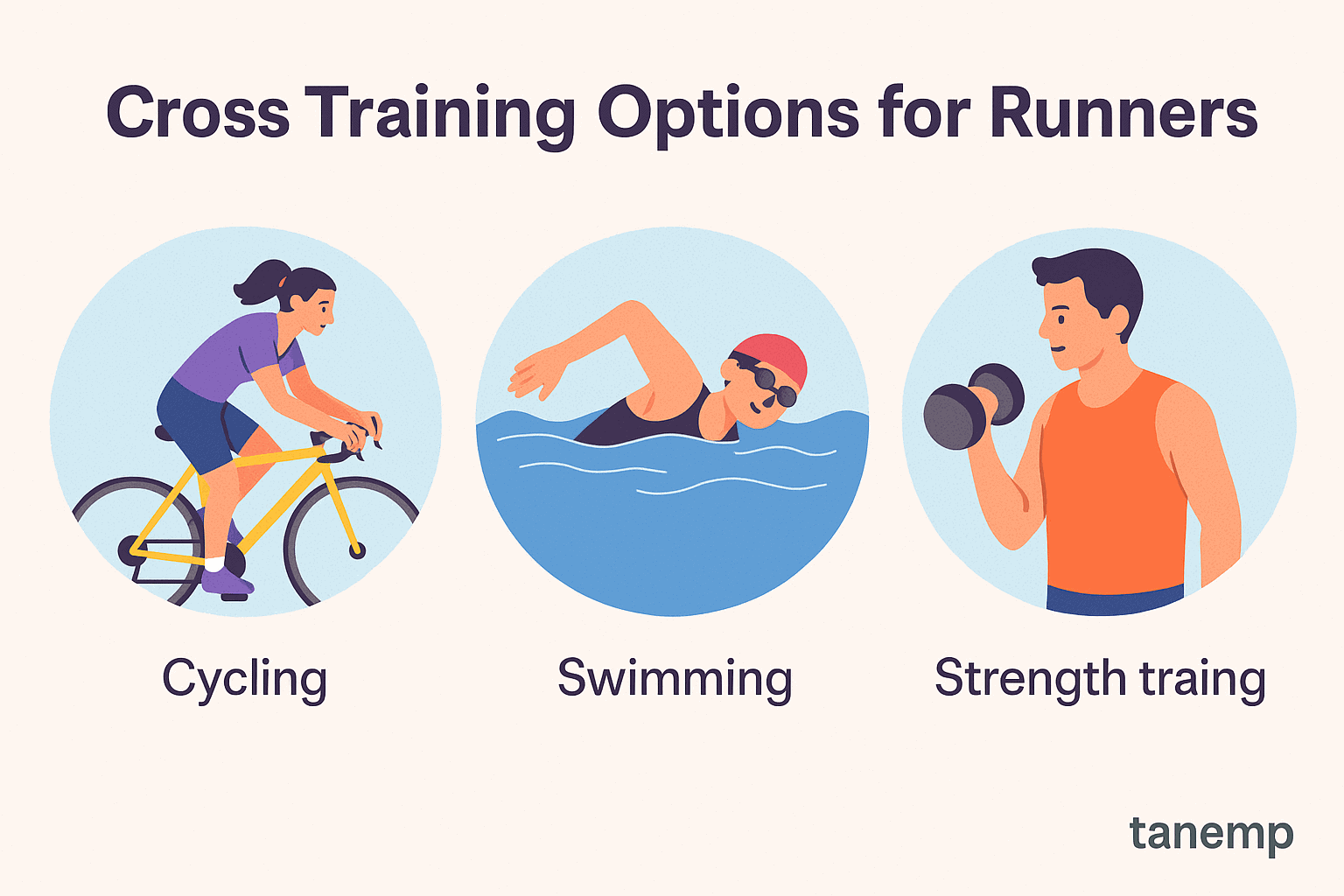
Not every workout has to be a run.
Cross-training gives your musculoskeletal system time to recover while still improving your cardiovascular fitness, strength, and endurance. It also lowers your injury risk, especially important for new runners.
Engaging in a variety of activities helps you strengthen different muscles, support joint health, and prevent overuse injuries.
Here are great cross-training activities that pair well with running:
- Brisk walking – Low-impact, great on recovery days
- Cycling – Builds endurance and leg strength
- Swimming – Zero impact and full-body conditioning
- Elliptical – Mimics running without the pounding
- Strength training – 1–2x/week for joint support, power, and injury prevention
- Yoga or Pilates – Improve flexibility, mobility, and balance
Even for complete beginners, these workouts help you stay active without stressing the same running muscles day after day. Plus, they offer excellent training benefits for your cardiovascular system, helping you become a stronger, more well-rounded runner.
A Sample Weekly Beginner Running Plan
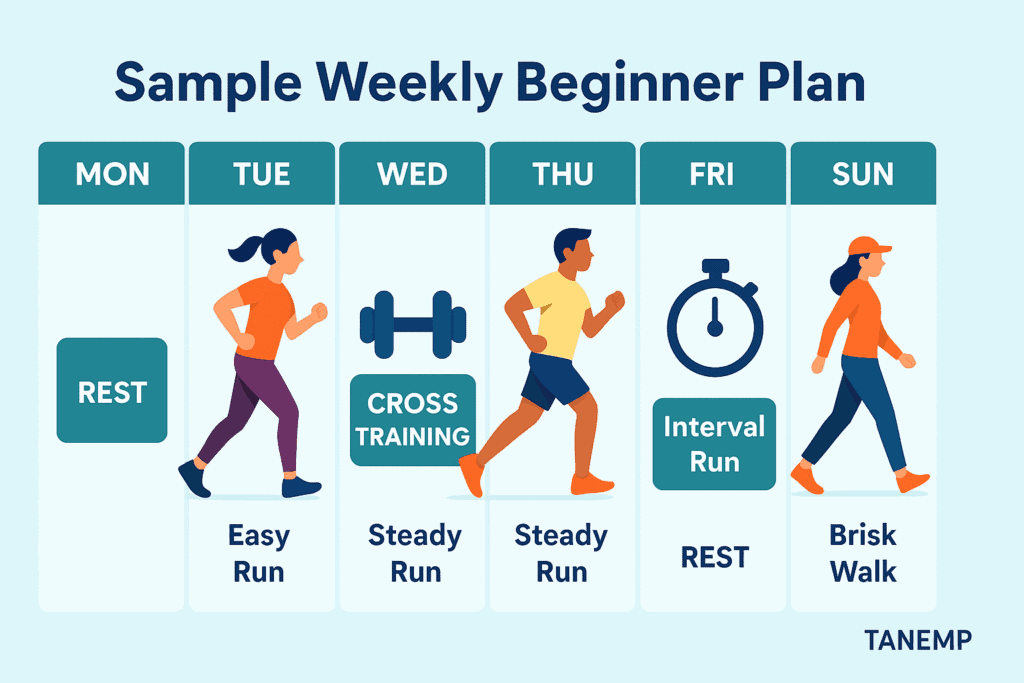
Here’s a simple, balanced schedule for new runners:
Day | Activity |
|---|---|
Mon | Rest or a short walk |
Tue | Easy run (10–20 mins) |
Wed | Cross-training or rest |
Thu | |
Fri | Rest |
Sat | Easy jog or strength training |
Sun | Optional run or complete rest |
This plan blends running days, optional cross-training, and adequate rest, so your body can adapt without injury. If you’re just starting your journey, consider pairing this with a Couch to 5K plan for extra structure and long-term motivation.
It also limits your weekly running volume, making it a good starting point that you can adjust based on results.
How to Know If You’re Running Too Much (or Not Enough)
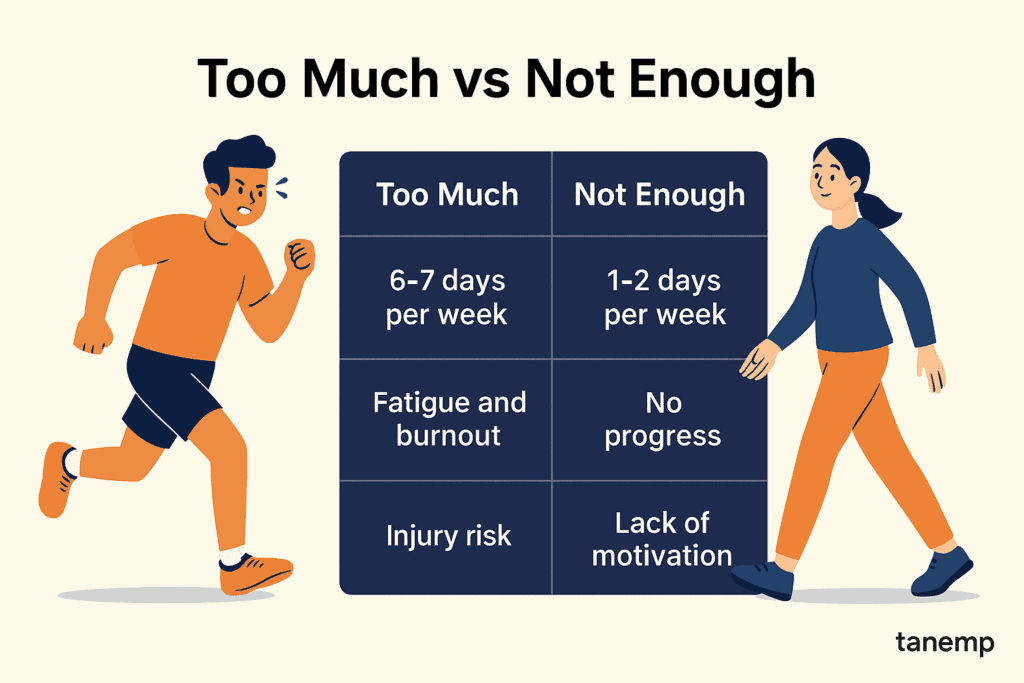
Striking the right balance is key, especially when you’re just getting started.
Here’s a quick comparison to help you spot the signs:
Running Too Much | Ready to Run More |
|---|---|
Constant fatigue or soreness | Runs feel easy and manageable |
Dreading your runs | Recovery is quick after each workout |
Slower performance despite high effort | You’re motivated and want to progress |
Long recovery time between runs | You feel stronger and more consistent |
Your training frequency should evolve, not based on pressure, but on how your body feels. If you have an injury history or tend to be injury-prone, ease up and stay flexible with your plan.
How Your Schedule Evolves With Experience

In the first few weeks, your focus should be on:
- Building the habit
- Avoiding injury
- Staying consistent
If you’re struggling to stay on track early on, finding the right running motivation can make all the difference. Staying consistent is easier when you have a reason to lace up.
As you stick with a regular running routine, your body adapts — and that opens the door to more progress.
Over time, as you become a more experienced runner, you can:
- Follow a structured training plan or training program
- Increase your weekly running volume and set new running goals
- Add hill repeats, tempo runs, or threshold runs
- Include faster running sessions, while still respecting your rest days
Many runners eventually work up to running 4–5 days per week. But even elite runners prioritize recovery. Your running routine should constantly evolve with your fitness level, lifestyle, and goals.
And if you’re unsure when or how to level up? That’s where a running coach can be helpful.

Wrap Up
You don’t need to run every day to become a strong, successful runner — not even marathoners do that. The smartest runners mix in cross-training, strength work, and rest days to stay consistent and injury-free.
Many beginners see the best progress by running just 3 to 4 days a week. It’s not about doing more — it’s about doing what you can stick with.
Build a routine that fits your life, not one that burns you out. Over time, you’ll get stronger, go farther, and enjoy the process.
👉 Want to keep progressing? Learn how to run faster and longer without burning out.
Run smart… and stay off my treatment table for knee pain.
Disclaimer: This article is based on my experience as a licensed chiropractor and recreational runner. The information provided is for educational and informational purposes only and is not intended to replace medical advice, diagnosis, or treatment. Always consult with your healthcare provider before beginning a new exercise program, especially if you have pain, injuries, or medical concerns.
❓ FAQs: Beginner Running Frequency Questions
Should I run every day as a beginner?
No. Most training programs recommend 2–4 days a week with rest days in between. Daily running increases injury risk without building extra benefits early on.
How many days per week should I run to lose weight?
3–4 running days per week, combined with cross-training and smart nutrition, is enough to support weight loss, especially when combined with walking and moderate intensity exercise.
What if I miss a day or two?
That’s normal. Focus on training consistency over time, not perfection week to week. Life happens — just get back on track.
Can I add strength or weight lifting on off days?
Yes, especially for injury prevention and better balance. Focus on core, glutes, hamstrings, and calves.
What’s a good starting point if I’ve never run before?
Start with 2 runs/week plus walking. Combine with a simple training program like walk/run intervals, and gradually build from there.





